Breaking down food sustainability by taking a virtual trip down the food value chain.
As Published in Eartha Mag on October 12, 2017
Feature Image: Wild Kaapi Coffee Farm; Image Courtesy Avinash Sosale
In 2009, opinion editor of Scientific American, Michael Lemonick wrote an article titled Top 10 Myths about Sustainability, the first myth being ‘Nobody knows what sustainability really means.’ It has been eight years since this article saw the light of day and the buzzword seems to be everywhere now. In spite of this omnipresence, I am not sure if what Lemonick pointed out as a myth is, in fact, one. Do we know what sustainability really means?
We love the word ‘sustainability’ in all aspects, and we especially love it when it comes to our food. Sustainability is now a shopping priority and companies have definitely taken notice of this consumer preference. A survey of 30,000 people across 60 countries by Nielsen shows that the biggest drivers while choosing sustainable products are when they come from companies that are environment-friendly, known for their commitment to social values and when products are made using organic or natural ingredients. The survey found that people have a strong response to claims of sustainability when buying consumables. Baby food, coffee, tea, and snacks see the majority of sales in this context. A study by Unilever published in January this year corroborates these facts and finds that this trend of purpose-led purchasing is greater among consumers from the emerging economies of India, Brazil, and Turkey.
Looks like we have our priorities right and are willing to spend money on products that matter. However, in understanding sustainability, it seems we are simply led by terms such as ‘fresh’ and ‘organic’ or by broad environmental claims that brands make about free trade and energy-efficient processing. In his article aptly titled Shades Of Sustainability, Aaron French writes that when talking about sustainability, we need to emphasise the time and place. “This is because sustainability is grounded in our environment, and our environment is cyclical in nature,” he writes.
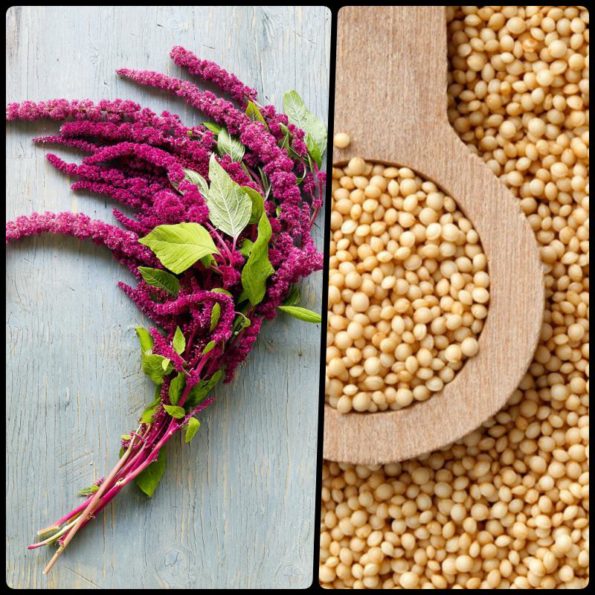
Without understanding that there are in fact shades to sustainability, the process of achieving sustainability remains something of a black box which the product labels don’t reflect because it does not fit our rigid terms.
What Does Sustainable Food Really Mean? Click To TweetIn this article, we try to demystify food sustainability by taking a virtual trip down the food value chain.Talking to people who operate at different points or sometimes throughout the chain, we see that sustainability manifests itself in different ways and may not always carry that shiny stamp at the end.
“A sustainable food system is a collaborative network that integrates several components in order to enhance a community’s environmental, economic and social well-being. It is built on principles that further the ecological, social and economic values of a community and region.” – Community Research Connections.
Acknowledging the problem
“The first thing we need to do is to understand that food is not a solved issue,” says Dwiji Guru, independent technology developer for sustainable agricultural solutions. Guru has been working with farmers, helping and supporting them in millet cultivation. Through his blog and talks, he is also working on increasing knowledge among urban consumers. “We isolate food under the pretext that people who manufacture and work with food know what they are doing. Sustainability is not just about identifying the right sources for our food, he says. Unless we acknowledge our lack of understanding, we will not feel the need to spend time and effort on it. He adds that there is a significant distance between the producer and the consumer, which adds to this isolation of food related issues.”
Similar to what French wrote, Guru explains that for every place the resource availability is different, which means sustainability applies itself differently. Take this simple example: the past two months have been so wet in Bangalore that if I had a mushroom bed, I would have had a bumper mushroom harvest. Yet, we don’t see an abundant mushroom supply in the market, do we? Mushrooms continue to come from niche production centres in far-off places. If we were in sync with our local environment, we would be able to provide solutions no matter what the situation
“For every place, the resource availability is different, which means sustainability applies itself differently.”
Guru points out that the homogenisation of our food is indicative of a lack of natural operations. At one point, we were consuming many different kinds of grains like maize, oats and millets, but the scales now tip towards sameness in product and variety. As this graph from the National Geographic shows, rice and wheat are the most important food crops in the world, having the biggest share in per capita calorie consumption.
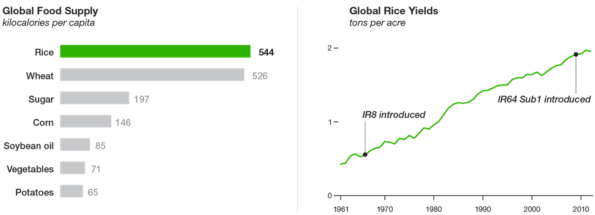
So, is sustainability about syncing with our local environment and resources to produce local foods? Guru adds that we also need to have a minimum impact on the ecology. “We have to see how we can return nutrients to a form that other species can utilise, by say, converting farmyard waste to more available nutrition for cattle and goats, or by composting kitchen waste. We need to return the nutrients as close to the source of our food as possible.”
Being future focused
Shankar Venkataraman of Mapletree Farms moved to India after a decade of farming in the US to implement his vast experience here and encourage organic farming. He begins the conversation on food sustainability mentioning the need to focus on reviving existing natural resources for our future generations to use. Using the example of soil, he says, “You cannot sustain a resource that is depleting, and soil is a depleting resource largely deficient in minerals. There is no point in growing organic food, or any food for that matter, in it. Food must be a source of nourishment, but if the required minerals are not available in the soil, they won’t be in the plant and thus, in our food. Unless we build soil fertility, we won’t be able to withdraw from it.”
Mapletree not only aims to improve organic farming, but also educates farmers and those interested in agriculture. Education, he insists, is vital in reviving our agriculture as our fundamental knowledge has been lost in translation. The farm has created its own mix to improve soil fertility which consists of cow dung, Indian earthworm, neem cake, herbal leaves and other local ingredients. Venkataraman shares that while this mix works on Indian soil, it was not what he could use back in the States.
“Sustainability, from where we stand at this point, is only in theory. For me, it’s first about saving our resources and educating people to do it the right way. We need to ensure that the resources are available for future generations to grow food, as is the practical know how. This is where we must begin our journey towards a sustainable food system.”
Connecting the dots
As important as implementing sustainable practices at the source of food is ensuring that the product of all this hard work reaches consumers with maximum returns and minimal wastage. Crop Connect, a sustainable supply chain venture founded by Ishira Mehta and Puneet Jhajharia aims to do just that. From their extensive travels to farms all across the country, the duo found that the paths between farmers and consumers are highly disrupted. In their interview with Forbes, the team shares that Arunachal Pradesh, for example, grows almost 4000 tons of kiwis a year. Unfortunately, farmers, not knowing how to sell their fruits end up abandoning the orchards.
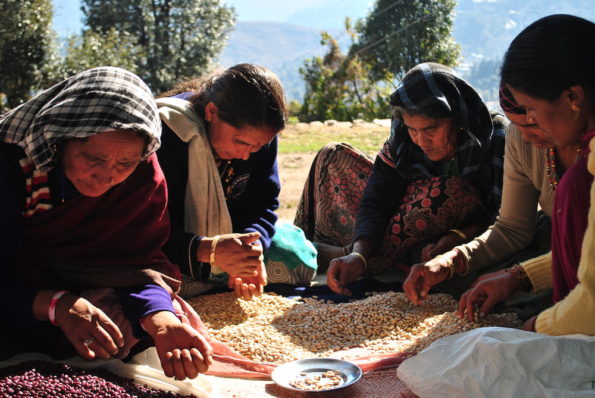
Through their e-commerce platform, The Original Indian Table, Crop Connect gives farmers direct market access and trains them on processing and packaging their products to meet market needs. “At Crop Connect, we believe in something called the interconnectedness of things,” they say. “Sustainability is when we can go a full circle in the food value chain with the least negative footprint. This includes everything from soil, water, packaging and transport.” If a farmer is growing something that is locally suited, it adds minimal stress on the land, on available resources and on the farmer himself. Such products are good for us as well. Sustainability is not just about the crops and resources, it is also about the farmer’s livelihood. If the farmer’s livelihood is not sustainable, there is no one to grow your food,” says Mehta.
“Sustainability is when we can go a full circle in the food value chain with the least negative footprint.
It is imperative that we talk about livestock when we discuss food sustainability. After all, close to a billion of the world’s poorest people rely on livestock for their livelihood and the rearing of what is local and regionally appropriate is equally important in the case of livestock. The Holstein dairy cow is a case in point; originally from Europe and now found in Europe and North America, these dairy cows produce up to 30 litres of milk per day. But when imported and bred in Asia and Africa, the yield falls to a third as they are not very resistant to tropical climates. To promote responsible seafood consumption, ventures like Know Your Fish try to raise consumer awareness about buying seafood in a manner that does not destroy the marine ecosystem.
The human face of sustainable food
The social aspect of sustainability is often integrated by providing support to external organisations. However, some businesses find ways to merge this into the food value chain. If you are looking for healthy alternatives to traditional or not-so-traditional snacks in Chennai, you will most likely turn to Terra Earthfood – Meera Maran’s world of everything that is ‘wholesome and mindful’. But Maran also ensures that her enterprise provides skill development and a sustainable source of income for those who need it most. When Maran set up Terra’s first store, she employed women from the surrounding areas who previously worked as masons, fisherwomen or domestic help. Terra now has three branches in Chennai, and Maran says as far as employment goes, she wouldn’t have it any other way.
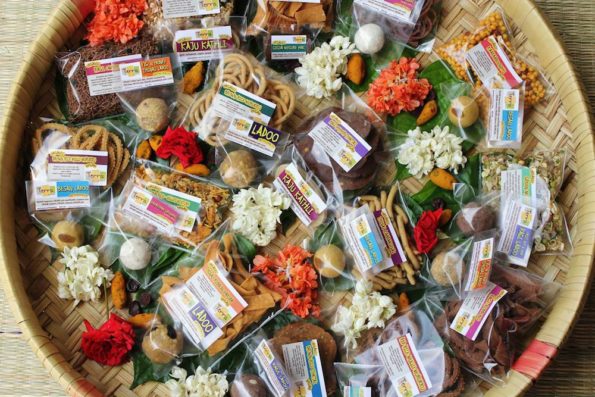
“Before the store, I first began by catering food and asked my cook to help me out,” Maran says. “Our food was well received, and right after the first order, we got many requests. My cook involved her relatives, and from there the staff grew organically. Imagine people who have no prior experience with baking, now actually come up with recipes. I think it’s wrong to call it philanthropic or social sustainability. They are great at what they do and just needed the right opportunities.”
Ask Reema Sathe, founder of Happy Roots, a venture which works with farmers and rural women in Maharashtra, and you might get a similar response. Happy Roots encourages farmers to grow indigenous, local grain varieties and trains rural women in turning them into interesting snacks. In doing this, Happy Roots ensures these rural communities own 50 percent of the food chain. Based on Sathe’s interactions with the farming communities, she found that while they were interested in food processing, farmers were not aware of the kind of products that would pique interest among new age consumers.
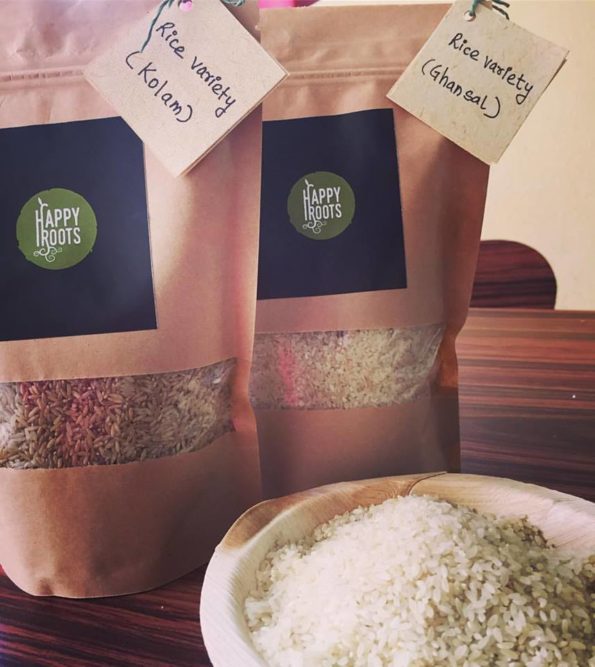
“The concept of sustainability, the way I see it is applicable when all the stakeholders, be it humans, the environment, the resources – everybody and everything – benefits from our activities in the food value chain. That is when the cycle is complete”, Sathe says. She adds that currently there is a huge gap in information. Farmers do not have access to market information, and consumers to information about farms or agriculture. There is a lack of transparency in the food value chain, and that is why I feel the need for increased awareness. We have a long way to go before sustainability as a phenomenon percolates down to the masses.”
More than food
Most narratives about sustainability talk about local produce, resource management, packaging and transport. But there are a few missing pieces that are not immediately associated with food sustainability. Consider the source; farms are not just places where our food grows, but are often adjacent to or part of an ecosystem that fosters other species of flora and fauna as well. Ventures like Wild Kaapi highlight this symbiosis and encourage farmers to practice coffee growing keeping this delicate balance in mind. Wild Kaapi sells single origin coffees from farms that are certified Wildlife-Friendly and have agreed to labour and agricultural practices that ensure sustainable livelihoods for them and others who live on these farms.
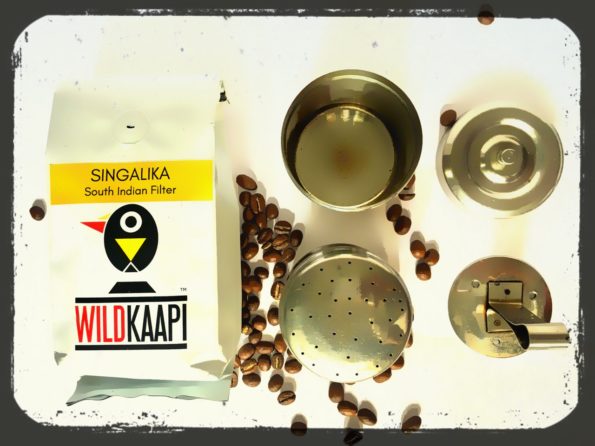
The other issue that rarely ever finds a place in this discussion is the source of our celebratory food – food we eat in restaurants. When it comes to sustainability, we think the choice of restaurant is all that matters. But as Saru Jayaraman, co-founder ROC-United (Restaurant Opportunities Centres United) and author of Behind The Kitchen Door rightly shares, it does not matter if the restaurant curates a menu that is local when the person cooking the food is paid low wages or forced to cook even when sick.
“….sustainable food has to mean more than that, because food isn’t really healthy if it’s served in restaurants where abuse, exploitation and discriminatory labour practices are commonplace,” writes Jayaraman. The book focuses on restaurants in the United States, but the issues highlighted are universal and definitely not yet a part of our sustainability narrative.
There is more to sustainability in food than meets the eye. I’ve tried to highlight these hidden layers to encourage dialogues that are comprehensive. You’ll notice that food waste has been left out of this article because it warrants a space of its own and will be addressed separately. But for now, here are ten points from the concluding chapter of writer and activist Raj Patel’s book Stuffed and Starved where he suggests ways to reclaim our food sovereignty:
- Transforming our tastes
- Eating locally and seasonally
- Eating agro-ecologically
- Supporting locally owned businesses
- Honouring all workers’ right to dignity
- Profound and comprehensive rural change
- Living wages for all
- Support for a sustainable architecture of food
- Snapping the food system’s bottleneck
- Owning and providing restitution for the injustices of the past and present.
Featured Image: Pexels.com
You may also like.
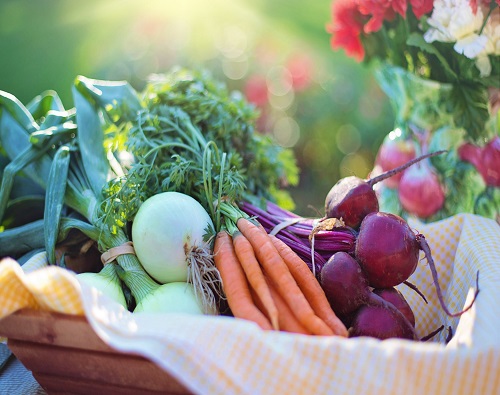
Thank you. I’m finding my way around this and this article adds a lot of value.
Thank you so much.
hi just dropped into your page and clicked on NEW HERE? and read sustainable food really mean, well explained in detail covering all aspects great.
I am farmer from ooty, grow culinary herbs naturally.
Sivaram
Thank you so much Sivarama :).